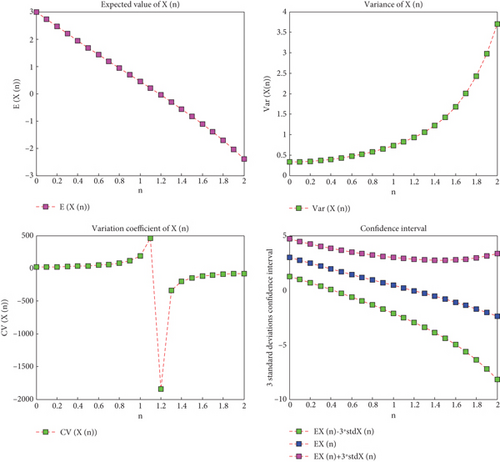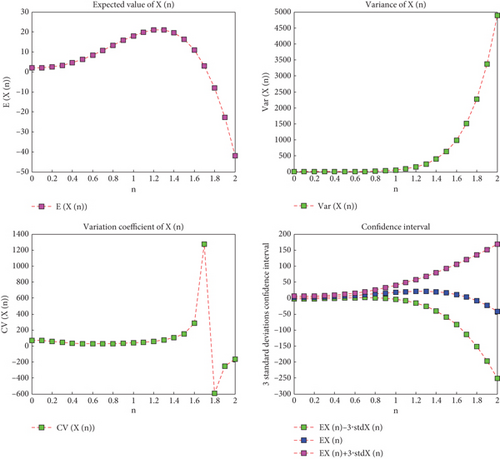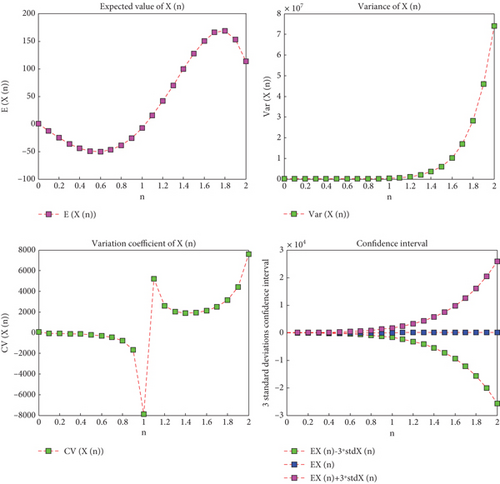Analysis of Random Difference Equations Using the Differential Transformation Method
Abstract
The differential transformation method (DTM) is one of the best methods easily applied to linear and nonlinear difference equations with random coefficients. In this study, we apply the theorems related to the DTM to the given examples and investigate the behaviour of the approximate analytical solutions. The expected value, variance, coefficient of variation, and confidence intervals of the solutions of random difference equations obtained from discrete probability distributions such as uniform, geometric, Poisson, and binomial distributions will be calculated. Maple and MATLAB software packages are used to plot the solution graphs and also to interpret the solution behaviour.
1. Introduction
The differential transformation method was introduced by Zhou in 1986 for solving linear and nonlinear problems involving electrical circuit problems [1]. The differential transformation method is a numerical technique based on the Taylor series expansion, which forms an analytical solution in polynomial form, and from this technique, the exact solutions for the differential or the integrodifferential equation are obtained [2]. Abbasov and Bahadir and Abdel and Hassan [3, 4] used the differential transformation method to obtain approximate solutions of linear and nonlinear equations related to engineering problems and observed that the numerical results were in good agreement with analytical solutions. In addition, the operations performed are possible to solve linear or nonlinear problems of difference equations.
The theory of difference equations, which has attracted much attention in the last few years, is rapidly advancing in a wide range of applications. While random dynamical systems can mathematically express an equation, events observed in nature represent a dynamical process. These systems are time-varying systems. Difference equations arise in the discretisation methods of differential equations. Difference equations have many applications in many fields of mathematics and science such as economics, biology, signal processing, computer engineering, genetics, medicine, ecology, and fixed point theory [5]. Difference equations, which have applications in various branches of science, lead to many mathematical analyses. The method we have developed here is applied to obtain the solution of initial value problems, difference equations, and boundary value problems. With the rapid progress of science, complex nonlinear difference equations allow us to analyse more easily [5–8].
In this article, the solution of difference equations is calculated with the help of the differential transformation method. Section 2 contains definitions and fundamental theorems with DTM. In Section 3, the basic technique of difference equations is given. In Section 4, brief information about discrete probability distributions is given, and in Section 5, the results are calculated by applying them to numerical examples.
2. Differential Transformation Method
The theorems obtained from Equations (1) and (2) are given below:
Theorem 1. If y(x) = f(x) ± g(x), then Y(k) = F(k) ± G(k).
Theorem 2. If y(x) = cf(x), then Y(k) = cG(k), where c is a fixed number.
Theorem 3. If y(x) = dng(x)/dxn, then Y(k) = ((k + n)! /k!)G(k + n).
Theorem 4. If y(x) = f(x)g(x), then .
Theorem 5. If y(x) = xn, then Y(k) = δ(k − n), where
Theorem 6. If y(x) = f1(x)f2(x) ⋯ fn−1(x)fn(x), then
Theorem 7. If y(x) = f(x + a), then for N⟶∞.
Proof 1. Using the definition of DTM in Equation (2),
By combining these given series
And in the transformation definition in Equation (2), if Y(k) is written as follows:
Theorem 8. If y(x) = f1(x + a1)f2(x + a2), where
for N⟶∞.
Proof 2. Let C1(k) be the differential transform of f1(x + a) and C2(k) be the differential transform of f2(x + a) at x = x0. Using Theorem 4, the differential transformation of y(x) is obtained as follows:
And from Theorem 7,
and
Using values
Theorem 9. If y(x) = f1(x + a1)f2(x + a2) ⋯ fn−1(x + an−1)fn(x + an), then
Proof 3. Let Ci(k) be the differential transform of fi(x + ai) at x = x0 for i = 1, 2, 3, ⋯, n. Then, using Theorem 6, we obtain the differential transformation of y(x) as follows:
And using Theorem 7,
By utilising these values,
In general,
Theorem 10. If
Proof 4. Let Ci(k) be the differential transform of gi(x + ai) for i = 1, 2, 3, ⋯, n and i = 1, 2, 3, ⋯, m. Let hj(x)Hj(k) for x = x0. Then, using Theorem 6, we obtain the differential transformation of y(x) as follows:
Using Theorem 7,
By utilising these values,
In general,
Theorems 1–5 are well known in the literature, and they cannot be proved here, and the proof of Theorem 6 is available in [9].
3. Solution Techniques for Difference Equation
The solution of difference Equation (3) requires the solution of the coefficients F(0), F(1), ⋯, F(N), so we must have N + 1 equations for N + 1 unknowns. From Equation (6), we have n equations given as BC, and the remaining N − n + 1 equations must be obtained from Equation (5) for k = 0, 1, ⋯, N − n. If Equation (3) is linear, the problem is simply to take the inverse of the coefficient matrix and multiply it by the right-hand side of Equation (5), but if Equation (3) is not linear, the set of equations must be solved by one, for example, Newton’s method. The differential transformation method has been applied to chaotic models, Volterra and Fredholm integral equations, fractional order equations, and partial differential equations and has been used to obtain very useful solutions [11–17].
4. Probability Distributions in Discrete Time
Definitions of some commonly used concepts in probability are provided in this section [18].
4.1. Discrete Uniform Distribution
Definition 1. Assume that k is an integer bit. The discrete uniform chance variable is the term used to describe a random variable with probability function.
Theorem 11. When has a uniform distribution that is discrete, then
- a.
- b.
- c.
4.2. Bernoulli Distribution
Definition 2. An random variable is referred to as a Bernoulli random variable if there are only two possible outcomes. The probability mass function is used to derive Bernoulli variables.
Theorem 12. If has a Bernoulli distribution,
- a.
- b.
- c.
4.3. Binomial Distribution
Definition 3. Let the random variable be the total number of people who passed n independent Bernoulli trials. The probability of failure for a particular experiment is , whereas the likelihood of success is represented by . The probability function of the binomial random variable is as follows:
The calculation of consecutive binomial probabilities is as follows:
Theorem 13. If has a binomial distribution,
- a.
- b.
- c.
4.4. Geometric Distribution
Definition 4. A geometric random variable is the number of experiments conducted in a Bernoulli experiment repeated n times successively in order to get the first intended result (success or failed). This variable’s distribution is known as the geometric distribution, and its probability function is the geometric random variable , with a single experiment’s probability of success being and of unsuccessfulness being .
Theorem 14. If has a geometric distribution,
- a.
- b.
- c.
4.5. Poisson Distribution
Definition 5. . The Taylor expansion of the function ey and the probability function gives :
Theorem 15. If has a Poisson distribution,
- a.
- b.
- c.
5. Numerical Results
Example 1. Consider the following linear difference equation with variable coefficients:
Let us examine the solution behaviour of the equation with A ~ U(α = 2, β = 4) uniformly distributed random variables and B ~ Be(p = 2/3, q = 1/3) Bernoulli distributed random variables.
It can be seen from Equations (13) and (14) that the coefficients of the series vary with N, which is a consequence of the implicit behaviour of the solution technique. With N = 4, comparative numerical results and the exact solution of x(n) = B2n − (A + B)n + A are obtained.
For higher order moments of random variables, the approximate expected value, variance, and coefficient of variation (CV) are calculated. For a uniformly distributed random variable X
Figure 1 provides the solutions for the expected value, variance, CV, and confidence interval of the n ∈ [0, 2] distribution. It can be noted that the mean value lowers as the variability increases, indicating an increase in random fluctuations.

Table 1 provides the expected value, variance, and confidence interval for K = 3 values. As can be observed, the outcomes for values of n ∈ [0, 1] are obtained in a manner akin to that of the case with uniform and Bernoulli parameters.
Example 2. Consider the following linear difference equation with variable coefficients:
| n | E[X(n)] | Var[X(n)] | CV[X(n)] | E[X(n)] − 3Std[X(n)] | E[X(n)] + 3Std[X(n)] |
|---|---|---|---|---|---|
| 0 | 3 | 1/3 | 19.245008 | 1.267949 | 4.732050 |
| 0.1 | 2.729993 | 0.337082 | 21.267020 | 0.988228 | 4.471758 |
| 0.2 | 2.462796 | 0.348337 | 23.964692 | 0.692191 | 4.233400 |
| 0.3 | 2.198949 | 0.367122 | 27.554344 | 0.381231 | 4.016668 |
| 0.4 | 1.938760 | 0.393487 | 32.355007 | 0.569021 | 3.820618 |
| 0.5 | 1.682296 | 0.427534 | 38.867182 | −0.279287 | 3.643880 |
| 0.6 | 1.429391 | 0.469448 | 47.933910 | −0.626098 | 3.484882 |
| 0.7 | 1.179643 | 0.519561 | 61.103760 | −0.982775 | 3.342062 |
| 0.8 | 0.932410 | 0.578437 | 81.568281 | −1.349242 | 3.342062 |
| 0.9 | 0.686817 | 0.647008 | 117.11531 | −1.726287 | 3.099922 |
| 1 | 0.441752 | 0.726756 | 192.98157 | −2.115748 | 2.999252 |
Let us examine the solution behaviour of the equation for random variables with geometric distribution A ~ G(p = 3/4, q = 1/4) and B ~ P(λ = 2).
It can be seen from Equations (21) and (22) that the coefficients of the series vary with N, which is a consequence of the implicit behaviour of the solution technique. With N = 4, comparative numerical results and the exact solution of x(n) = 2n − 7n + An + B are obtained. Higher order moments of the random variables, approximate expected value, variance, and CV are calculated. The geometrically distributed random variable X
Figure 2 provides the solutions for the expected value, variance, CV, and confidence interval of the n ∈ [0, 2] distribution. The data shows a gradual initial increase followed by a subsequent fall in the expected value, but the variance exhibits a rapid and significant increase, indicating a substantial rise in random effects.

Table 2 provides the expected value, variance, and confidence interval for K = 3 values. As can be observed, the outcomes for values of n ∈ [0, 1] are obtained in a manner akin to that of the case with geometrical and Poisson parameters.
Example 3. Consider the following linear difference equation with variable coefficients:
| n | E[X(n)] | Var[X(n)] | CV[X(n)] | E[X(n)] − 3Std[X(n)] | E[X(n)] + 3Std[X(n)] |
|---|---|---|---|---|---|
| 0 | 2 | 2 | 70.710678 | −2.242640 | 6.242640 |
| 0.1 | 1.999737 | 2.024747 | 71.156150 | −2.269071 | 6.268545 |
| 0.2 | 2.398769 | 2.119308 | 60.688813 | −1.968584 | 6.766122 |
| 0.3 | 3.243344 | 2.351539 | 47.280599 | −1.357073 | 7.843763 |
| 0.4 | 4.544127 | 2.860287 | 37.218112 | 0.529587 | 9.617842 |
| 0.5 | 6.276193 | 3.903728 | 31.480635 | 0.348836 | 12.20355 |
| 0.6 | 8.379034 | 5.946421 | 29.102738 | 1.063449 | 15.69461 |
| 0.7 | 10.75655 | 9.804476 | 29.109787 | 1.362924 | 20.15018 |
| 0.8 | 13.27707 | 16.87378 | 30.938832 | 0.953758 | 25.60038 |
| 0.9 | 15.77331 | 29.47173 | 34.417538 | 0.513045 | 32.05968 |
| 1 | 18.04244 | 51.32852 | 39.708558 | −3.450738 | 39.53561 |
Let us examine the solution behaviour of the equation A ~ B(p, q) with binomially distributed random variables p = 4/5, q = 1/5.
is obtained.
Figure 3 provides the solutions for the anticipated value, variance, CV, and confidence interval of n ∈ [0, 2]. The observed trend shows that the anticipated value initially experiences a tiny fall, followed by an increase, and then another decrease. Meanwhile, the variance remains constant initially but increases significantly after the value of n reaches 1.4, indicating a substantial rise in random effects.

Table 3 provides the expected value, variance, and confidence interval for K = 3 values. As can be observed, the outcomes for values of n ∈ [0, 1] are obtained in a manner akin to that of the case with binomial parameters. In the present study, the approximate analytical series solution was obtained by applying the differential transformation method to ordinary random difference equations. Since DTM is a Taylor series–based method, the accuracy and speed of random DTM provide quite accurate results for the mean, variance, and confidence interval functions of a random difference equation. There are few studies in the literature on approximate analytical solutions of random difference equations. As a result, this method is easy and efficient to apply to linear and nonlinear random difference equations where the randomness in the equation is introduced by analytical m.f.stochastic processes.
| n | E[X(n)] | Var[X(n)] | CV[X(n)] | E[X(n)] − 3Std[X(n)] | E[X(n)] + 3Std[X(n)] |
|---|---|---|---|---|---|
| 0 | 0.8 | 0.16 | 50 | 0.400000 | 2 |
| 0.1 | −12.75742 | 67.28754 | −64.29899 | −37.36612 | 11.851266 |
| 0.2 | −25.35018 | 395.5429 | −78.45412 | −85.01496 | 34.314606 |
| 0.3 | −36.15602 | 1350.502 | −101.6405 | −146.4035 | 74.091530 |
| 0.4 | −44.39071 | 3719.446 | −137.3874 | −227.3525 | 138.57107 |
| 0.5 | −49.33056 | 9104.636 | −193.4261 | −335.5852 | 236.92408 |
| 0.6 | −50.33969 | 20619.57 | −285.2524 | −481.1252 | 380.44586 |
| 0.7 | −46.90238 | 44092.02 | −447.6979 | −676.8454 | 583.04068 |
| 0.8 | −38.66109 | 90101.09 | −776.4095 | −939.1664 | 861.84425 |
| 0.9 | −25.46019 | 177367.9 | −1654.153 | −1288.912 | 1237.9921 |
| 1 | −7.395918 | 338316.3 | −7864.468 | −1752.345 | 1737.5532 |
6. Conclusion
In this study, the random effects of different distributions on difference equations are investigated by using the differential transformation method. The expected value, variance, CV, and confidence intervals of the solutions of random difference equations are calculated by applying the discrete probability distributions of uniform distribution, Bernoulli distribution, geometric distribution, binomial distribution, and Poisson distribution to the series solutions of three linear random difference equations. In the first examples given, by using the uniform distribution for the expected value, it is seen that the expected value is at the highest level at n = 0 and the value E[X(0)] = 3 is obtained, and for the variance, it is shown that there is a random effect using the Bernoulli distribution, and this random effect is shown in the table. Similarly, in the second example, using the geometric distribution of the expected value, it is seen that the expected value is at the highest level at n = 1 and the value E[X(1)] = 18.04244 is obtained, and the variance is randomised using the Poisson distribution and these effects are tabulated. In Example 3, since there is only one variable; only the binomial distribution is applied, and it is seen that the expected value is at the highest level at n = 2 and the random effect of E[X(1)] = 168.5 is calculated and written in a table. The obtained series solutions are compared with the exact solutions, and the numerical results are shown to be a suitable method for the DTM difference equation solution.
Conflicts of Interest
The authors declare no conflicts of interest
Author Contributions
All authors have contributed equally to the study. The authors have read and agreed to the published version of the manuscript.
Funding
The authors received no specific funding for this work.
Open Research
Data Availability Statement
Data sharing is not applicable to this article.




